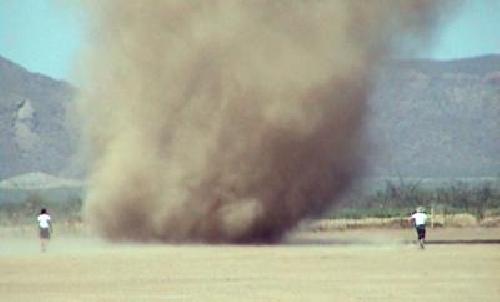SAN FRANCISCO--Buried in the shallow soft mud of a dry California lake bed, a seismometer was able to detect the tiny tilts of the ground as it was pulled up by passing dust devils. The experiment, described online November 10 in the Bulletin of the Seismological Society of America, is one of the first reports of a seismic signature from a dust devil.
The study provides valuable information to researchers working on NASA's InSight mission to Mars, which will deposit a similar seismometer on the Red Planet. InSight's scientists hope the device will help them measure dust devils and their impact on the Martian atmosphere, according to Ralph Lorenz of Johns Hopkins University and colleagues. Scientists could also subtract the seismic noise created by dust devils from the seismometer's overall readings as they look for evidence of "marsquakes."
Previous Mars missions such as the Mars Expedition Rover Spirit have filmed dust devils and the tracks they leave behind, where the devils scour away the planet's loose surface soil to reveal darker rock below. When these tracks accumulate over large regions, Lorenz said, they can cause changes in solar reflection "which may cause year-to-year variations in Mars' otherwise fairly uniform climate."
 With an eye to learning more about Martian dust devils, in 2005 researchers chased a large dust devil near Eloy, Arizona. Credit: NASA/University of Michigan
With an eye to learning more about Martian dust devils, in 2005 researchers chased a large dust devil near Eloy, Arizona. Credit: NASA/University of Michigan
"While on Earth dust devils are generally just an occasional nuisance and meteorological curiosity," Lorenz adds, "on Mars, they are major agents of dust-raising, which is a major factor in the climate, and in the operation of solar-powered vehicles on Mars."
To learn more about the kinds of information InSight's seismometer might be able to collect, Lorenz and colleagues tested a seismometer on a desert playa near Goldstone Deep Space Communications Complex outside of Barstow, California. While the area was mostly free of vehicles and foot traffic, the scientists had to fence in their instrument array to protect it from wild donkeys and other wildlife that roamed the dry lake bed.
The whirl of a dust devil occurs when ground heating creates a layer of hot, buoyant air that rises in plumes and begins to spin. These vortices are usually invisible, unless they pick up a cloaking layer of dust. In effect, the vortices are miniature low pressure systems, where air presses down on the ground with less weight inside the system compared to outside the system.
Lorenz and colleagues deployed eight pressure loggers in a cross formation around the seismic station. Their goal was to see if they could match up instances of sharp, temporary pressure drops--which would indicate a passing dust devil--with any distinctive seismic signatures produced at the same time.
The researchers were able to pair two dust devil pressure drops, 10 minutes apart, with seismic signatures. The seismometer proved to be sensitive enough to measure ground tilts of about 12 millionths of a degree caused by the dust devils, they found.
A dust devil measuring about 10 meters in diameter can cause a drop in pressure equivalent to removing the weight of a small car from the ground surface, Lorenz noted. "So a large dust devil can cause a very significant change in the loading of the ground, and it is no surprise the ground deforms by a tiny amount," he said. "In essence, the dust devil sucks on the ground, pulling it upwards like a tablecloth pinched between thumb and forefinger. So the ground tilts away from the dust devil."
Data collected by the seismometer can tell the researchers something about the direction of the dust devil's path, and the overall tilt signal also provides a picture of how elastic the ground is when it pulls up and settles again in the wake of the vortex. Elasticity is partially determined by the composition of rocks and dust that make up the ground, making it a useful tool in exploring the nature of Mars' near-surface layers.
source: Seismological Society of America